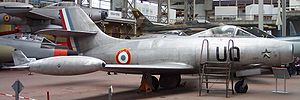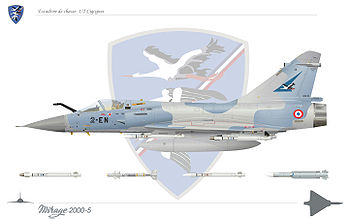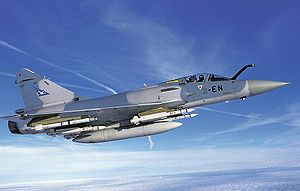- 1/2 fighter squadron Storks
-
 EC 1/2 squadron emblem
EC 1/2 squadron emblem
The 1/2 fighter squadron "Storks" (French language: escadron de chasse 01.002 "Cigognes" or l'EC 1/2) is a French Air Force fighter squadron, currently stationed in 102 Dijon-Longvic Airbase (BA 102, (IATA: DIJ, ICAO: LFSD)). It inherits the traditions of three notable World War I units: SPA 3 of the famous ace Georges Guynemer, SPA 103 of René Fonck, and SPA 12.[1]
Contents
History
Before and during World War I
Following a decision taken by the French Army General Council,[2] in June 1912, the first flights of the French air arm were formed. One of these was established at the army camp of Avord, in Cher. Its designation, B.L. 3, arose from the aircraft type with which it was equipped, the Blériot XI. Once established, the flight moved eastward, towards Alsace. The sight of this 'migration' led to comparison with the storks which are harbingers spring in Alsace. So the name 'Cigogne' came to be associated in people's minds with B.L. 3.[3] Alsace had been part of France until 1871 but in 1912 was part of Germany. The association therefore touched French pride.
It was not until 1916, under the pressure of the Great War in which aircraft numbers grew rapidly, that the association between the emblem and the unit became official. So that aircrews should be able to recognise other members of their own flight, in order to regroup after dispersal during fighting, the command of the Somme Combat Group, of which flight.3 was then a part, ordered that clear symbols be painted on aircraft. By this time, the flights had been grouped into squadrons. The squadron's commanding officer, Commandant Brocard chose to make reference to the Alsatian storks by using a white stork with lowered wings as the emblem on the Nieuports of no. 3 flight. He then ordered the other flights of the squadron to choose emblems using storks in other postures.[4] The modern emblem of the squadron bears three storks at three points in the wing-beat cycle. They represent respectively Flight 3 (wings low), Flight 103 (wings high) and Flight 12 (wings spread).[5]
World War II
Having distinguished itself during the Battle of France in 1940, the squadron was disbanded in August. However, it was re-formed in July 1941 and equipped with Dewoitine D.520s. In 1942, it was sent to North Africa where it took its opportunity, with other units, to join the Free French Forces and was shipped to Ayr, in Scotland. There it was designated as No. 329 Squadron RAF. On 6 June 1944, it took part in the D Day Landing and from 19 August, was again based in France, at Sommervieu, Normandy, under Captain Ozanne. At this period, it specialized in ground attack but aerial combat was still part of the job and in December 1944, the squadron was faced with its first Jet-propelled opposition. In July 1945, fifteen aircraft of the squadron took part in the victory fly-past, celebrating an honourable end to the Second World War.[6]
Post World War II
 One MD 450 Ouragan of 1/2 fighter squadron Storks.
One MD 450 Ouragan of 1/2 fighter squadron Storks.
In November 1945, the squadron, EC 1/2 Cigognes was re-established as a unit of the French Air Force. In June 1946 it left for French Indochina where it flew Supermarine Spitfire, with the SPA 3 flight stationed at Saigon and SPA 103 at Hanoi. On its return to Metropolitan France, in 1948, it was remounted in Republic P-47 Thunderbolts.
In 1949, EC 1/2 Cigognes moved to its present base at Dijon-Longvic, at the same time, remounting in jet-propelled De Havilland Vampires, followed by Dassault MD 450 Ouragans, then Dassault Mystère IVAs. It was in this aircraft that the squadron was engaged during the Suez Crisis, in 1956. Notably, it became the first unit of the French Air Force to deploy a indigenous Mach-2 fighter, the new Mirage IIIC, on 7 July 1961.[7] In 1968 these were replaced by Mirage IIIE.
In 1984, EC 1/2 Cigognes moved on to the Mirage 2000C. In September 1994, it received a third flight: the SPA 12. At the end of the 1990s, the squadron moved to Mirage 2000-5F.
Constituent flights
Bases
- Avord (formation 1912)
- Châteauroux (1941–1942)
- North Africa (1942–1943)
- 1944-1945 see Free French Forces RAF service
- Koblenz/Coblence (1948–1949)
- Station 102, Dijon-Longvic (fr) (since 1949)
Aircraft
- Blériot XI (1912)
- Nieuport two-seaters (1912)
- Breguet (1914)
- Voisin (1914)
- Morane Saulnier (1915)
- Nieuport Scouts (1915)
- Nieuport 11 (1915)
- Nieuport 12 (ca 1915 - 1916)
- Nieuport 16 (ca 1915 - 1916)
- Nieuport 17 (ca 1915 - 1916)
- Spad (1917 - 1918)[8]
- Dewoitine D.520 1939-1944
- 1944-1945 see Free French Forces RAF service
- Supermarine Spitfire (1945–1947)
- Republic P-47 Thunderbolt (1948–1949)
- De Havilland Vampire (1949–1953)
- Dassault Ouragan (1953–1956)
- Dassault Mystère IVA (1956–1961)
- Dassault Mirage IIIC (1961–1968)
- Dassault Mirage IIIE (1968–1984)
- Dassault Mirage 2000C (1984–1999)
- Dassault Mirage 2000-5F (since 2000)
See also
References
- French Air Force web site (Archived 2009-09-03) (fr)
- The history page of the squadron's web site (Archived 2009-09-03) (fr)
- * Over the Front: A Complete Record of the Fighter Aces and Units of the United States and French Air Services, 1914-1918 Norman L. R. Franks, Frank W. Bailey. Grub Street, 1992. ISBN 0-948817-54-2, 9780948817540.
Footnotes
- ^ Air Force site.
- ^ Law of 29th March 1912. “Military aeronautics is charged with the study, the acquisition or the construction and the putting into a working state, of aerial navigation devices useable by the Army, such as balloons, aeroplanes and kites.” This was not strictly, the founding of the French Air Force but it was an effective step in that direction. Accessed 2009-08-30. Archived 2009-09-03.
- ^ Squadron site
- ^ Squadron site
- ^ The three emblems may be seen separately at the foot of the squadron’s page in the Air Force site. While the squadron's emblem has all three birds in black and white, the individual emblem of No. 12 Flight is in black and silver. Accessed 2009-08-30. Archived 2009-09-03.
- ^ Air Force site. For a fuller coverage of this period, see No. 329 Squadron RAF.
- ^ Pierre-Alain Antoine (Sep 2011). "Memories of a Mirage driver". Aircraft: 87. ISSN 20412150.
- ^ Over the Front: A Complete Record of the Fighter Aces and Units of the United States and French Air Services, 1914-1918. p. 89–90; 103–104.
External links
Categories:- French Air Force bases
- French Air Force squadrons
Wikimedia Foundation. 2010.


